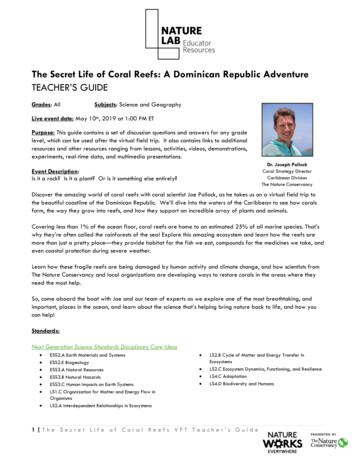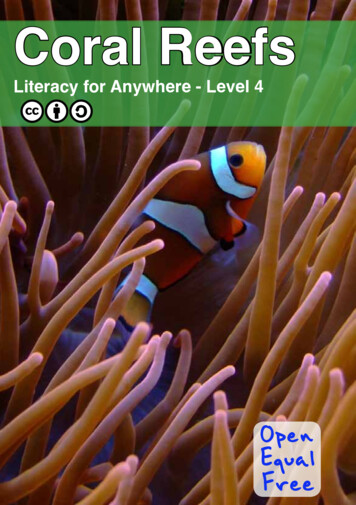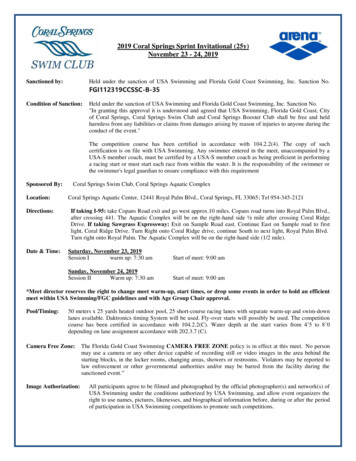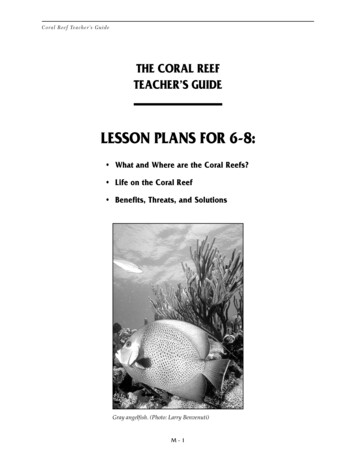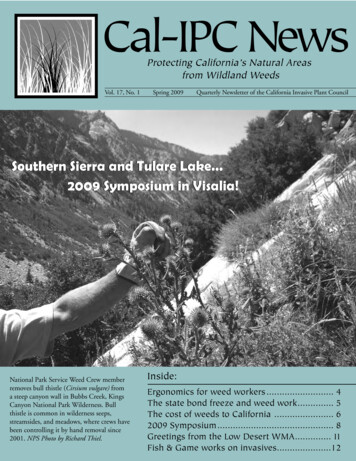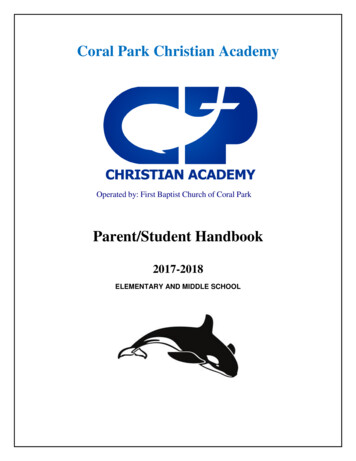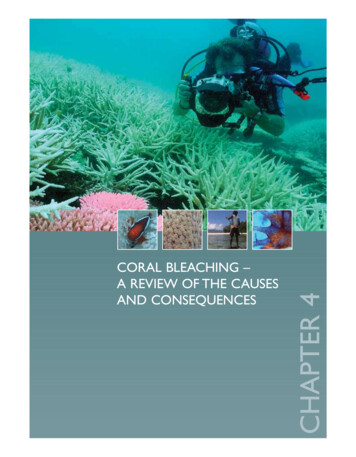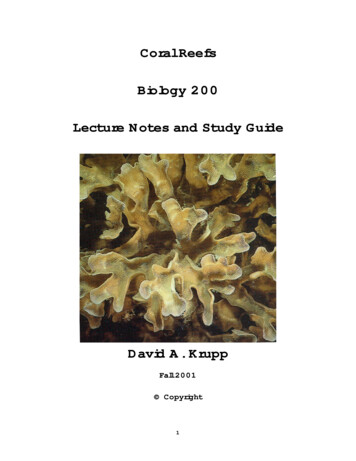
Transcription
Coral ReefsBiology 200Lecture Notes and Study GuideDavid A. KruppFall 2001 Copyright1
Using this Lecture Outline and Study GuideThis lecture outline and study guide was developed to assist you inyour studies for this class. It was not meant to replace your attendanceand active participation in class, including taking your own lecture notes,nor to substitute for reading and understanding text assignments.Inaddition, the information presented in this outline and guide does notnecessarily represent all of the information that you are expected to learnand understandin this course.You should try to integrate theinformation presented here with that presented in lecture and in otherwritten materials provided.It is highly recommended that you fullyunderstand the vocabulary and study questions presented.The science of biology is always changing.New information andtheories are always being presented, replacing outdated information andtheories. In addition, there may be a few errors (content, spelling, andtypographical) in this first edition. Thus, this outline and guide may besubject to revision and corrections during the course of the semester.These changes will be announced during class time.Note that this lecture outline and study guide may not be copiednor reproduced in any form without the permission of the author.
TABLE OF CONTENTSThe Nature of Natural Science . 1The Characteristics of Living Things . 6The Classification of Living Things . 13Characteristics of Phylum Cnidaria and Cnidarian Diversity. 17The Anatomy and Morphology of Scleractinian Corals . 22Coral Nutrition . 28Reproduction of Scleractinian Corals . 33Basic Ecological Principles . 41Environmental Factors Influencing Corals . 51Coral Reef Ecology. 59Coral Reef Formation and Geomorphology . 63Fish Biology . 70Human Impact on Coral Reefs . 84APPENDIX I: Chemical Principles . 97APPENDIX II: Animal Body Plans.106APPENDIX III: Major Animal Phyla Characteristics .112eggcloudspawningcoral10 cm (approx.)Female Mushroom Coral Fungia scutaria Spawning
When space turned around, the earth heatedWhen space turned over, the sky reversedWhen the sun appeared standing in shadowsTo cause light to make bright the moon,When the Pleiades are small eyes in the night,From the source in the slime was the earth formedFrom the source in the dark was darkness formedFrom the source in the night was night formedFrom the depths of the darkness, darkness so deepDarkness of day, darkness of nightOf night aloneDid night give birthBorn was Kumulipo in the night, a maleBorn was Po'ele in the night, a femaleBorn the coral polypBorn of him a coral colony emerged.[pp. 3-4, Johnson, R.K., 1981.The Kumulipo: Hawaiian hymm of creation. Vol. 1. Topgallant Publishing Co., Ltd., Honolulu, HI, 188pp.]
THE NATURE OF NATURAL SCIENCEI.Science as a Way of KnowingA. Some Natural Science Disciplines1. biology2. chemistry3. physics4. geology5. astronomy6. meteorologyB. What Is Natural Science?1. involves attempts to explain observable phenomena in the natural universe2. involves a process by which we investigate the natural universe3. involves the body of information collected by this processC. Unprovable Assumptions Upon Which Science is Based1. the universe is real and the human mind is capable of understanding its truenature and there are no mysteries being deliberately cloaked from ourview and understanding2. all observable phenomena are the effects of previous underlyingmeasurable natural causes3. the universe is unified by natural laws that are constant in time and spaceD. Characteristics of Scientific Explanations1. derived objectively from independently confirmable observations2. rational (that is they must be reasonable and logical)3. consistent with known natural laws and well-established, well-documentedexisting theories4 assume natural cause and effect5. objectively & empirically testable (i.e., potentially falsifiable)6. conclusions must always be regarded as tentative7. when an explanation is claimed to be scientific, but does not exhibit thecharacteristics listed above, then that explanation is said to bepseudoscientificE. Operational Rule: the simplest interpretation that is consistent with all of thepertinent data is most likely to be correct (i.e., it must be parsimonious)F. Limitations to Natural Science1. natural science can only study natural phenomena, phenomena that may beobserved (by direct observation or instruments) the same way by anyobserver2. the supernatural, spiritual and mystical cannot be studied by the methodsof natural science3. natural science can neither confirm nor refute supernatural, spiritual andmystical explanations4. thus theological ideologies and beliefs are inherently non-scientific and lieoutside of the realm of scientific endeavors5. science also does not make moral decision, but may provide objectiveinformation that may be used in making moral decisions6. natural science explanations should not be regarded as final truth evenwhen supported overwhelmingly by the evidence, rather, as a consequence1
Windward Community CollegeII.BIOLOGY 200 – Coral ReefsDr. Dave Kruppof the scientific method (see below), we either become more or lessconfident in the correctness of these explanations; however, explanationssupported overwhelmingly by the evidence may be considered "true beyonda reasonable doubt"G. Hypotheses, Laws, & Theories1. if after repeated testing, the hypothesis has not been disproved, then itmay become a theorya. like hypotheses, theories yield testable predictionsb. a theory never becomes absolute truth, but always possesses someamount of uncertaintyc. however most theories have been so strongly validated that they areoften considered to be true beyond all reasonable doubtd. a theory usually explains many different kinds observations (e.g.,evolution explains the fossil record, anatomical homologies, shareddevelopmental patterns, biochemical similarities, genetic similarities,biogeographical distributions, etc.)e. usually, rather than being falsified, most theories are revised as newobservations are collectedf. thus a theory is a very strong statement in science, surviving manyattempts to be falsifiedg. theories are widely accepted explanations for the mechanisms behindhow phenomena in nature are produced2. contrast a theory with a natural lawa. rather than explaining the mechanism behind a natural phenomenon, anatural law is a description of how nature appears to behaveb. theories, on the other hand, may provide explanations for themechanisms behind natural lawsc. natural laws may be tested through observation and experienced. examples of scientific laws1) Newton's Law of Gravity2) Mendel's Laws of Inheritance3) The First & Second Laws of Thermodynamicse. Is the concept of evolution a natural law, a theory, or a fact?The Scientific MethodA. General Comments about the Scientific Method1. leads to objective, unbiased evaluation of hypotheses2. explanations not constrained by an absolute truth3. self-correcting - scientific errors usually discovered4. leads to a methodical discovery of explanations for phenomena of thenatural universe5. while the steps of the scientific method (see below) are often presented asthough they are rigidly followed by practicing scientists, in fact, they arenota. scientists do not maintain a checklist of these stepsb. steps also ignore the importance of serendipity and intuition inthe process of scientific discoveryB. Steps1. observation2
Windward Community College2.3.4.5.6.BIOLOGY 200 – Coral ReefsDr. Dave Kruppa. observe phenomena in natureb. these observations must be capable of being observed by more thanone objective observerc. collecting observations often involves more than merely seeingsomething happend. may involve systematic collection of data using human senses and/ormeasurement tools and instrumentsquestiona. usually best to ask "how", "what" or "when" kinds of questionsb. best to avoid "why" questions that may suggest "ultimate design" or asupernatural "designer" is involved with the answerc. "why" questions often lead to teleological answers1) teleology to explain something in terms of fulfillment of purpose2) implies the purpose existed prior to its fulfillment - as thoughfulfillment was directed by a transcendent being or consciousness orby the evolving organisms themselves striving to achieve somelong-range evolutionary goal3) note: it is perfectly scientific to discuss the purpose or function ofa structure or behavior of an organism; it is not scientific to suggestthat such structures or behaviors were intended by some kind ofmystical or supernatural intelligenced. usually before attempting to answer the question (i.e., form ahypothesis), the investigator will make more observations aboutphenomena relevant to the questionhypothesisa. an educated guess that attempts to answer the questionb. involves inductive reasoning, whereby one derives general principlesfrom particular facts or instancesc. must assume the following characteristics of scientific explanations1) consistent with natural laws2) requires the involvement of natural cause and effect3) must be falsifiable, that is must lead to testable predictionspredictiona. an if-then statement based upon the hypothesisb. prediction is a consequence of the hypothesis should the hypothesis betruec. involves deductive reasoning, whereby one draws a conclusion fromstated premisestest the predictiona. experiments must have the potential to disprove the hypothesisb. experiments must be designed with appropriate controls (a control isa parallel experiment that helps isolate the variable being test againstall other possible variables that may influence the results, e.g., aplacebo is used as a control to test the medical effectiveness of a drug)c. results are collected as datad. test results are organized and analyzede. test should be repeated a number of timesconclusion3
Windward Community CollegeBIOLOGY 200 – Coral ReefsDr. Dave Kruppa. conclude whether or not the hypothesis has been refuted by the testb. should also conclude which aspects of the hypothesis and its test needfurther study1) what was inadequate about the study?2) should the hypothesis be modified?3) what other predictions might be tested?4) what new questions may be asked?7. present test results for critical reviewa. scientific study useless unless others can evaluate itb. formal presentation for critical review allows1) objective scrutiny of the methods and interpretation of the results2) other scientists to replicate the studyc. formats for presentation1) written report in peer-reviewed scientific journals (mostimportant format)2) oral presentations at scientific meetings8. retest the hypothesis or modified hypothesisa. test other predictions that may be made from the hypothesisb. this retesting may be repeated until hypothesis is well-supported bythe evidence and widely accepted by scientists, thus becoming a theoryTEXT PAGES COVEREDvii-xVOCABULARYnatural sciencepredictionnatural ific methodvariableparsimonyobservationnatural lawcontroldatanaturalhypothesiscause and effectdeductionteleologysupernaturalSTUDY QUESTIONS1.Describe the scope of the Natural Sciences2.Describe the steps in the Scientific Method. Give a "realistic" example of how itmight be used.3.Explain the three assumptions that scientists make to interpret the naturaluniverse; and discuss the characteristics that make explanations of naturalphenomena scientific. Support your essay with examples.4.Discuss the limitations of science as an system of epistemology. In other words,what kinds of phenomena are studiable by science? What kinds are not? Givesome specific examples to support your discussion. Can science ever produce anyabsolute truths?4
Windward Community CollegeBIOLOGY 200 – Coral ReefsDr. Dave Krupp5.Contrast hypotheses, theories, and laws.discussion.6.Creationism is the belief that the biblical account of the origin of the universe, theearth, and all living things, as presented in the Book of Genesis, gives an accuratedescription. Many creationists also hold to the view that creationism is a scientificaccount. Regardless of the truth or falseness of this account, explain whycreationism cannot be regarded as a scientific explanation (be sure to read GenesisI & II in the Old Testament before attempting to answer this question.)5Provide examples to support your
THE CHARACTERISTICS OF LIVING THINGSI.Great Complexity & OrganizationA. Observations Regarding the Complexity of Living Things1. living things much more highly organized than inanimate objects2. composed of complex, large, highly improbable moleculesB. Complexity Results from the Hierarchical Organization of Living Systems(Emergent Behavior)atomsimple inorganic moleculeorganic building block moleculemacromoleculecellular organellecelltissueorganorgan e1. atomsa. fundamental particles of matter defining the elementsb. cannot be broken down into smaller particles using conventionalchemical proceduresc. examples of some of the major elements comprising living things1) carbon (C)2) hydrogen (H)3) oxygen (O)4) nitrogen (N)5) phosphorus (P)6) sulfur (S)2. simple inorganic moleculesa. molecule combination of two or more atomsb. inorganic molecules not composed of carbon atoms bonded to eitherother carbon atoms (C-C bonds) nor to hydrogen atoms (C-H bonds)c. examples of inorganic molecules important to living things1) water (H2O)2) carbon dioxide (CO2)3) molecular oxygen (O2)4) ammonium (NH3)3. organic building block moleculesa. organic (i.e., possesses C-C and/or C-H bonds) molecules used toconstruct larger molecules or used as sources of chemical energyb. some examples6
Windward Community College4.5.6.7.8.9.BIOLOGY 200 – Coral ReefsDr. Dave Krupp1) glucose, a simple sugar (C6H12O6)2) glycine, an amino acid (C2H502N)3) acetate (C2H4O2)4) glycerol (C3H8O3)5) adenine, a nitrogenous base in DNA (C5H5N4)macromoleculesa. very large molecules assembled from repeating series of the organicbuilding block moleculesb. some examples1) starch, assembled from hundreds of glucose units2) proteins, assembled from hundreds of different amino acids3) nucleic acids (e.g. DNA & RNA), assembled from thousands ofnucleotides (each nucleotide nitrogenous base plus ribose sugarplus phosphate group)4) fats, assembled from glycerol and fatty acids; note fatty acidscomposed of long changes carbon from combining acetatemolecules togethercellular organellesa. structural components of living cellsb. each structure serves a particular functionc. some examples1) nucleus: encloses the chromosomes which contain the geneticinstructions for the cell2) mitochondrion: important in the releasing of chemical energy fromorganic molecules3) chloroplast: captures light energy and converts this lightenergy into chemical energy as simple sugars (found in plant cells)4) flagellum: whip-like structure that moves the cellcells (see below)tissues (multicellular organisms only)a. groups of similar cells that perform a similar functionb. some examples1) epithelial tissues: forms body coverings2) connective tissues: forms skeletons and binds other tissuestogether3) nervous tissue: involved in sensing and responding to stimuli4) muscle tissue: involved movementorgansa. structures composed of several tissues working in concert for aparticular functionb some examples1) stomach2) liver3) intestines4) pancreas5) gall bladderorgan systemsa. a group of organs functioning together7
Windward Community College10.11.12.13.14.II.III.BIOLOGY 200 – Coral ReefsDr. Dave Kruppb. some examples1) digestive system2) reproductive system3) nervous system4) respiratory systemorganism the complete living entity, the individualpopulation collection of individuals, all of the same species, living insome defined geographical areacommunity a group organisms consisting of populations of differentspecies interacting with each other in some defined geographical areaecosystem the biological community plus its surrounding nonlivingenvironmentbiosphere all of the ecosystems of the earth; that part of the earthoccupied by living thingsCellsA. The Cell Theory1. all living things are composed of cells2. cell fundamental unit of lifeB. Characteristics of All Cells1. possess a surrounding membrane that maintains the internal integrity2. chemically complex interior where metabolism takes place3. genetic instruction set (chromosomes) defining their characteristicsC. Contrast Cells and VirusesD. Two Major Types of Cells1. prokaryotica. lacks a nucleus & other membrane-bound organellesb. characteristic of bacteria2. eukaryotica. possess a nucleus & other membrane-bound organellesb. characteristic of all other groups of living thingsc. distinguish animal & plants cells1) plant cells possess chloroplasts & cell walls of cellulose2) animal cells lack chloroplasts & cell wallsReproductionA. Characteristics of Reproduction1. living things make exact or nearly exact copies of themselves2. requires a mechanism for inheritance3. usually involves a process of development4. most parents produce more offspring than are required merely to replacethe parents when they dieB. Two Modes of Reproduction1. sexual reproductiona. involves fusion of gametes (usually haploid) to form zygotes (usuallydiploid); genetic information from parents combined in offspringb. offspring resulting from sexual reproduction are similar yet differentfrom both parentsc. advantage: offspring unique; provides for diversity within a species;diversity enhances species adaptability and survival when environments8
Windward Community CollegeIV.V.BIOLOGY 200 – Coral ReefsDr. Dave Kruppchanged. disadvantage: process generally complex since chromosomes must bedivided during gamete formation (meiosis) ; also need mechanisms forbring sperm & eggs together; process of development from fertilizedegg also complex (may involve larval stages)2. asexual reproductiona. does not involve combination of genetic information from two parents(i.e., no union of gametes)b. offspring usually clone of parent (genetically identical)c. advantage: simpler than sexual reproduction (no meiosis needed);offspring well-suited for survival in environment where parents occur(good if environment stable)d. disadvantage: leads to low diversity within a species; species may notinclude individuals capable of dealing with changes in the environmentC. Development and Growth1. most living things pass through a characteristic life cycle that involveschange in form and growth2. this change in form (e.g. a single-celled egg becoming a multicellularorganism) development3. most living things exhibit a net accumulation of organic materials: growthMechanism for Inheritance (Heredity)A. Characteristics of Genetic Instruction Set1. genetic instruction set of all living things contained in nucleic acids (DNA)of chromosomes2. instruction set defines the structure, functioning, & behavior (to someextent) of all living things3. instruction set, or portions of it, are passed from parent to offspringB. Mechanisms for Genetic Change Responsible for Evolution1. genetic recombination (exchanging of genes yielding new combinations ofexisting genes; e.g., sexual reproduction)2. mutation (involves change to the coding sequence of a single gene)3. chromosomal aberration (alteration of chromosomes affecting many genesat once)4. when genetic changes are passed on to offspring then the species mayevolveMetabolismA. definition1. all of the chemical processes that occur in living cells & organisms2. involves the acquisition & use of energy & materialsB. Energy1. the capacity to do work2. types of energy significant to living thingsa. mechanical energy (energy involved in movement)b. radiant energy (e.g., visible light and heat)c. chemical energy (energy stored in the chemical bonds of molecules)3. some energy-requiring processes of living thingsa. growth, reproduction & repairb. movement9
Windward Community CollegeBIOLOGY 200 – Coral ReefsDr. Dave Kruppc. maintaining homeostasisC. Examples of Metabolic Processes1. photosynthesisa. involves the synthesis of complex organic molecules (e.g., glucoseC6H12O6) from simpler inorganic molecules (e.g., carbon dioxide CO2 andwater H2O)b. this is an energy-requiring process: light energy from the sun isultimately converted into the chemical energy of the organic molecules1) light energy initially captured by pigment molecules (e.g., the greenchlorophyll pigment of plants)2) captured energy may be regarded as being stored by the C-C & C-Hbonds of organic molecules3) process involves many small chemical stepsc. overall chemical reaction:light energy 6CO2 6H2O C6H12O6 6O22. respirationa. involves the release of energy from organic molecules so that thestored chemical of these organic molecules may be used for energyrequiring processesb. overall chemical reaction (note that this is opposite of photosynthesis):C6H12O6 6O2V.VI. 6CO2 6H2O chemical energyInteraction with the EnvironmentA. Reciprocal Relationship Between Organisms and Their Environments1. living things modify their environmentsa. they remove resourcesb. they produce wastes2. the environment modifies the behavior and physiology of living thingsB. Contributes to Evolutionary Change1. environment constantly changing due toa. extrinsic factors (e.g., meteorite impacts, solar intensity, etc.)b. intrinsic factors (the activities of living things, e.g., oxygen productionby plants)2. if living things can’t adjust to these changes, extinction may resultAdaptabilityA. Evolution1. evolution genetic change of a population over generations2. if population changes substantially in its genetic composition, populationmay become a different species from what it once was3. over millions of years the changes can be very dramatic (e.g., dinosaursevolving into birds)4. common ancestrya. species sharing features in common likely to have descended from acommon ancestor through this process (e.g., human beings,chimpanzees, gorillas, thought to have descended from a common ape10
Windward Community CollegeBIOLOGY 200 – Coral ReefsDr. Dave Krupplike ancestor that lived about 5-10 million years agob. the history of life as a consequence of evolution may be likened to ahuge branching bush1) branch points common ancestors for divided smaller branches2) all existing species the growing branch tips3) many branches have died out, their lifeless ends representingextinctionB. Adaptation1. present day species are the products of thousands of adaptations evolvedby their ancestors2. the adaptations these species have acquired over many generationsthrough evolution enhance their survival3. process involves the production of heritable variations, natural selection,and chancea. production of heritable variations1) mutation: changes to genetic instructions of a gene2) chromosomal aberration: alterations to whole chromosomes orparts of them3) genetic recombination: "mixing and matching" of genes yieldingunique combinations of genesb. natural selection1) in a natural population, individuals exhibit variations in physicalcharacteristics and behavior2) some of these variations may result in higher probability ofreproductive success than others (let's call these variations"adaptive")3) individuals exhibiting these adaptive variations tend to contributeproportionately more offspring to the succeeding generation4) if these adaptive variations are heritable, then these offspring willlikely exhibit the same adaptive variations as did their parents5) with each succeeding generation, proportionately more individualsexhibit the adaptive variations6) over long enough periods of time, this process of change couldproduce new speciesc. chance1) not all changes in the genetic composition of a population driven bynatural selection2) probability exists that any variation may occur more commonlythan others in subsequent generations regardless of its influence onreproductive success3) such changes are more likely to occur in small populations thanlarge onesC. Evolution Inevitable1. changes to the genetic instruction set will definitely occur2. reproduction ensures genetic changes will be passed on to offspring3. natural selection means that the more adaptive genetic changes willbecome more common place in a population while less adaptive ones mayeventually disappear11
Windward Community CollegeBIOLOGY 200 – Coral ReefsDr. Dave Krupp4. over many generations adaptive and neutral genetic changes mayaccumulate5. given enough time (several billion years) the changes are enough toaccount for the species that presently exist on our planetVOCABULARYcomplexityorganic moleculetissuepopulationmutationeukaryotesexual nthesisnatural selectionmoleculeinorganic moleculecellular organellecellorgan systemorganismecosystembiospherehomeostasiscell theorynucleusasexual ic recombinationSTUDY QUESTIONS1.List and describe the characteristics associated with living things that distinguishthem from inanimate objects.2.Outline and describe the hierarchical organization of living systems.3.Define homeostasis and describe several examples of homeostatic mechanisms inliving things.4.Compare the major structural differences between prokaryotic and eukaryotic cells.5.Define sexual and asexual reproduction. Give the advantages and disadvantages ofeach.6.Contrast photosynthesis with respiration.overall chemical reactions in your answer.7.Briefly describe and explain the mechanisms of evolutionary change.8.Why does your instructor states that “Evolution is inevitable”?12Be sure to present their respective
THE CLASSIFICATION OF LIVING THINGSI.Dividing the Living World Into GroupsA. Reasons for Classification (Taxonomy)1. common basis for communication about different groups of living things2. human attempt to make sense of the tremendous diversity of the livingworld3. imply evolutionary relationships ( phylogeny)B. Nature of Groupings1. organisms placed within same group exhibit characteristics in common2. most groupings arbitrarily defined with evolutionary relationships in mind3. problem: nature not organized into neat, discrete packages4. hierarchical organization of classification groupsa. living world generally divided into five major groups, kingdoms, basedupon the fundamental characteristics of cells and they way they areorganized togetherb. each of these kingdoms are divided into subdivisions called phyla(singular phylum) or divisions1) all phyla within a kingdom consist of organisms that share kingdomcharacteristics in common2) organisms within a phylum (or division) share certaincharacteristics in common that distinguish them from members ofanother phylum within the same kingdomc. each phylum (or division) divided into subdivisions called classesd. each class divided into subdivisions called orderse. each order divided into subdivisions called familiesf. each family divided into subdivisions called genera (singular genus)g. each genus divided in subdivisions called speciesh. an example involving the mushroom coral:Figure iaExample of the hierarchical system of classifying living thingsusing the mushroom coral, Fungia scutariaC. Five Kingdoms of Life1. major characteristics used to classify living things into kingdomsa. cell structure1) prokaryote (no nucleus) versus eukaryote (has a nucleus)2) cell wall present or absent3) cell wall chemistry4) presence or absence of other organellesb. cellularity13
Windward Community CollegeBIOLOGY 200 – Coral ReefsDr. Dave Krupp1) unicellular versus multicellular2) level of organization of cells into tissuesc. mode of nutrition1) heterotrophya) utilize pre-made organic moleculesb) types1) saprophytic: secretes digestive enzymes to the exterior,then absorbs digested organic molecules (e.g., fungi)2) ingestive: digestion occurs internally after ingestion of food(e.g., most animals)2) autotrophya) manufactures organic molecules from inorganic startingmaterialsb) types1) photoautotrophy: use light energy (photosynthesis)2) chemoautotrophy: use chemical energy (chemosynthesis)2. characteristics of the five kingdomsa. Kingdom Monera1) prokaryotic, single-celled organisms2) while not very diverse morphologically, they are very diverse atthe biochemical level, including heterotrophic, photoautotrophic,and chemoautotrophic species3) some with cell walls, but cell walls composed of peptidoglycan, notcellulose (as in higher plants)4) includes eubacteria, cyanobacteria, and archaeobacteria5) more recent classification schemes divide Monera into two kingdomsb. Kingdom Protista1) eukaryotic, generally single-celled, organisms2) if multicellular, then cells not well-organized into tissues andorgans (more colonies of cells)3) a very heterogeneous group include both heterotrophic andphotoautotrophic forms4) includes protozoa (e.g., Paramec
Windward Community College BIOLOGY 200 - Coral Reefs Dr. Dave Krupp 5 5. Contrast hypotheses, theories, and laws. Provide examples to support your discussion. 6. Creationism is the belief that the biblical account of the origin of the universe, the earth, and all living things, as presented in the Book of Genesis, gives an accurate description.
